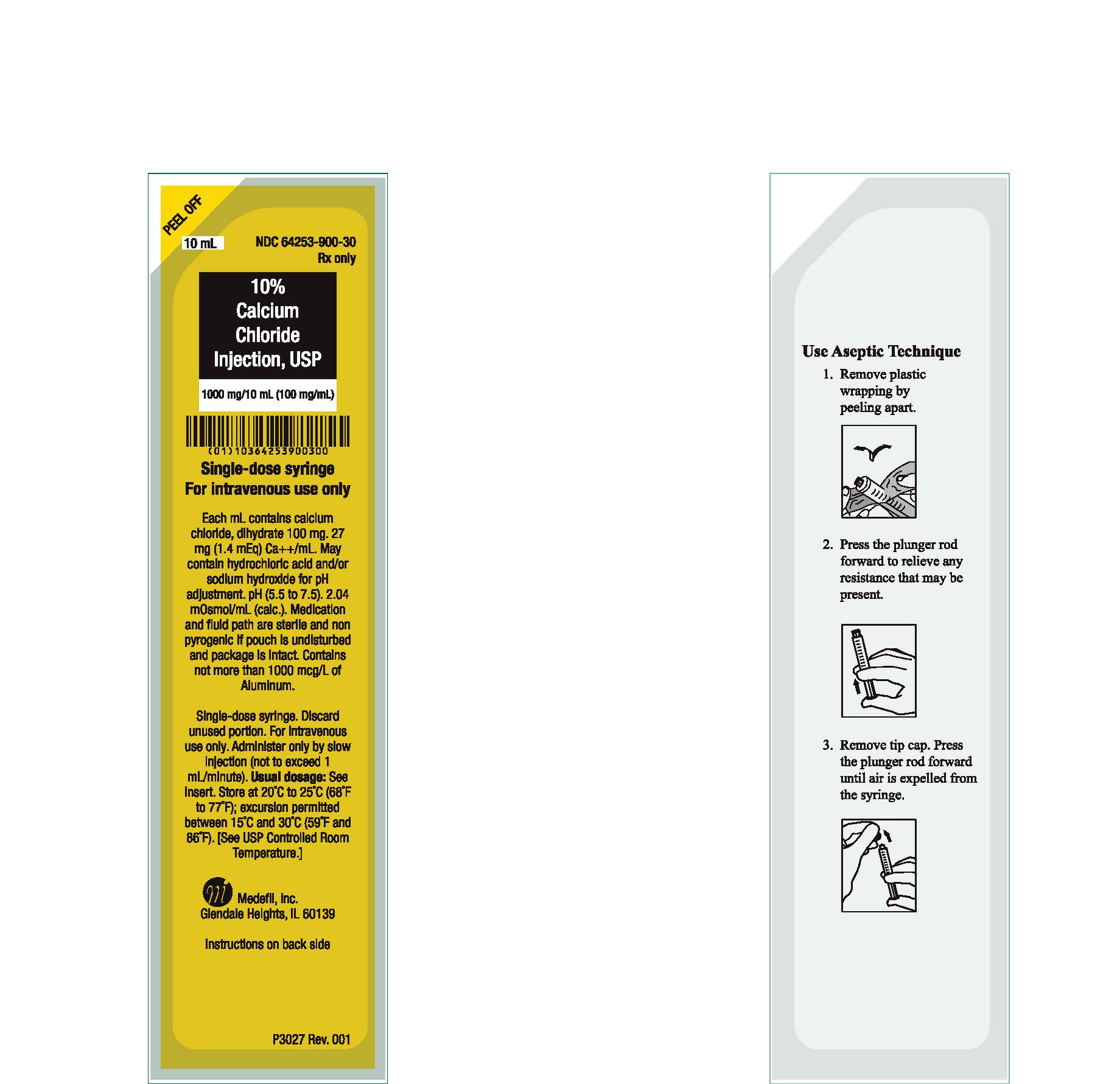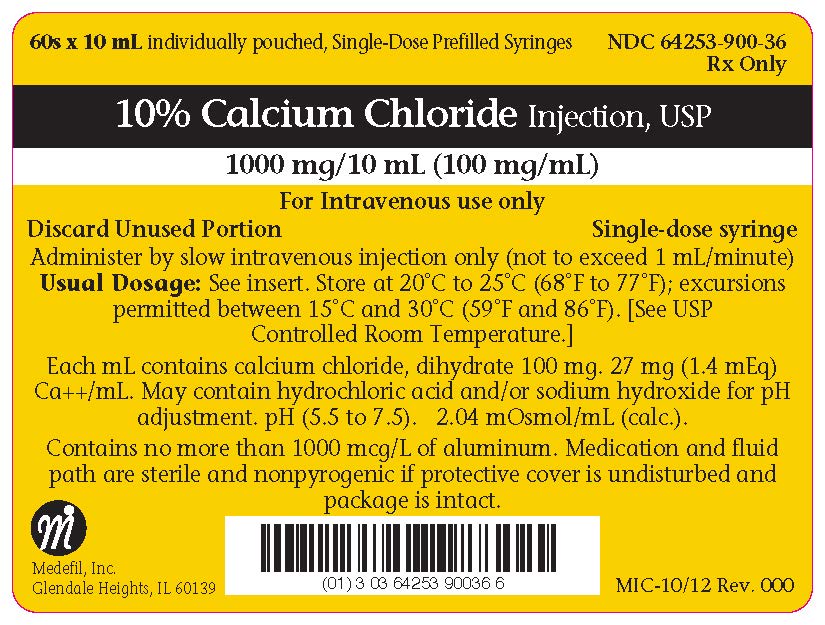CALCIUM CHLORIDE- calcium chloride injection injection, solution
Calcium Chloride by
Drug Labeling and Warnings
Calcium Chloride by is a Prescription medication manufactured, distributed, or labeled by Medefil, Inc.. Drug facts, warnings, and ingredients follow.
Drug Details [pdf]
-
HIGHLIGHTS OF PRESCRIBING INFORMATION
These highlights do not include all the information needed to use 10% CALCIUM CHLORIDE INJECTION, USP safely and effectively. See full prescribing information for 10% CALCIUM CHLORIDE INJECTION, USP.
10% CALCIUM CHLORIDE INJECTION, USP for Intravenous Injection
Initial U.S. Approval: 2019INDICATIONS AND USAGE
CONTRAINDICATIONS
ADVERSE REACTIONS
Rapid injection may cause the patient to complain of tingling sensations, a calcium taste, a sense of oppression or "heat wave".
Injections of calcium chloride are accompanied by peripheral vasodilatation as well as a local "burning" sensation and there may be a moderate fall in blood pressure.
Should perivascular infiltration occur, I.V. administration at that site should be discontinued at once. Local infiltration of the affected area with 1% procaine hydrochloride, to which hyaluronidase may be added, will often reduce venospasm and dilute the calcium remaining in the tissues locally. Local application of heat may also be helpful.
To report SUSPECTED ADVERSE REACTIONS, contact Medefil, Inc., at 1-630-682-4600 or www.medefilinc.com or FDA at 1-800-FDA-1088 or www.fda.gov/medwatch.
DOSAGE AND ADMINISTRATION
10% Calcium Chloride Injection, USP is administered only by slow intravenous injection (not to exceed 1 mL/min), preferably in a central or deep vein. (14)
The usual precautions for intravenous therapy should be observed. If time permits, the solution should be warmed to body temperature. The injection should be halted if the patient complains of any discomfort; it may be resumed when symptoms disappear. Following injection, the patient should remain recumbent for a short time. (14)
The usual adult dosage in hypocalcemic disorders ranges from 200 mg to 1 g (2 to 10 mL) at intervals of 1 to 3 days depending on the response of the patient and/or results of serum ionized calcium determinations. Repeated injections may be required because of rapid excretion of calcium. (14)
The pediatric dosage in hypocalcemic disorders ranges from 2.7 to 5.0 mg/kg hydrated calcium chloride (or 0.136 to 0.252 mEq elemental calcium per kg, or 0.027 to 0.05 mL of 10% Calcium Chloride Injection per kg). No data from clinical trials is available about repeated dosages, though textbook references recommend repeat dosages q 4 to 6 hours. (14)
Caution: 10% Calcium Chloride Injection consists of 1 gram of calcium chloride in a 10 mL syringe, or 100 mg/mL. This concentration represents 27 mg or 1.4 mEq of elemental calcium per mL. Thus, one 10 mL syringe provides 270 mg of elemental calcium. The dosage recommendation in various references is given either as amount of calcium chloride or amount of elemental calcium, and often it is not specified. Ionized calcium concentrations should be measured, to assist in dosage adjustment. (14)
Parenteral drug products should be inspected visually for particulate matter and discoloration prior to administration, whenever solution and container permit. See PRECAUTIONS. (14)
To prevent needle-stick injuries, needles should not be recapped, purposely bent or broken by hand. (14)
Revised: 9/2019
- Table of Contents
-
DESCRIPTION
10% Calcium Chloride Injection, USP is a sterile, nonpyrogenic, hypertonic solution. Each mL contains 100 mg (1.4 mEq/mL) of calcium chloride, dihydrate (1.4 mEq each of Ca++ and Cl−) in water for injection. It is provided in a 10 mL Unit of Use Syringe to facilitate prompt intravenous injection. The solution contains no bacteriostat, antimicrobial agent or added buffer and is intended for use only as a single-dose injection. The pH of 10% Calcium Chloride Injection, USP is 5.5 to 7.5 when diluted with water for injection to make a 5% solution. May contain hydrochloric acid and/or sodium hydroxide for pH adjustment. The osmolar concentration is 2.04 mOsmol/mL (calc.). 10% Calcium Chloride Injection, USP is oxygen sensitive.
Calcium Chloride, USP dihydrate is chemically designated CaCl2 2H2O (dihydrate) and is described as white, odorless fragments or granules freely soluble in water.
The plastic syringe is molded from a specially formulated polypropylene. Water permeates from inside the container at an extremely slow rate which will have an insignificant effect on solution concentration over the expected shelf life. Solutions in contact with the plastic container may leach our certain chemical components from the plastic in very small amounts; however, biological testing was supportive of the safety of the syringe material.
-
CLINICAL PHARMACOLOGY
Calcium is the fifth most abundant element in the body and the major fraction is in the bony structure. Calcium plays important physiological roles, many of which are poorly understood. It is essential for the functional integrity of the nervous and muscular systems. It is necessary for normal cardiac function and is one of the factors that operate in the mechanisms involved in the coagulation of blood.
Calcium chloride in water dissociates to provide calcium (Ca++) and chloride (Cl−) ions. They are normal constituents of the body fluids and are dependent on various physiological mechanisms for maintenance of balance between intake and output. Approximately 80% of body calcium is excreted in the feces as insoluble salts; urinary excretion accounts for the remaining 20%.
- INDICATIONS & USAGE
- CONTRAINDICATIONS
-
WARNINGS
10% Calcium Chloride Injection, USP is irritating to veins and must not be injected into tissues, since severe necrosis and sloughing may occur. Great care should be taken to avoid extravasation or accidental injection into perivascular tissues.
WARNING: This product contains aluminum that may be toxic. Aluminum may reach toxic levels with prolonged parenteral administration if kidney function is impaired. Premature neonates are particularly at risk because their kidneys are immature, and they require large amounts of calcium and phosphate solutions, which contain aluminum.
Research indicates that patients with impaired kidney function, including premature neonates, who receive parenteral levels of aluminum at greater than 4 to 5 mcg/kg/day accumulate aluminum at levels associated with central nervous system and bone toxicity. Tissue loading may occur at even lower rates of administration.
-
PRECAUTIONS
Do not administer unless solution is clear and seal is intact. Discard unused portion.
Because of its additive effect, calcium should be administered very cautiously to a patient who is digitalized or who is taking effective doses of digitalis or digitalis-like preparations.
Injections should be made slowly through a small needle into a large vein to minimize venous irritation and avoid undesirable reactions. It is particularly important to prevent a high concentration of calcium from reaching the heart because of the danger of cardiac syncope.
- CARCINOGENESIS & MUTAGENESIS & IMPAIRMENT OF FERTILITY
- PEDIATRIC USE
- PREGNANCY
-
GERIATRIC USE
An evaluation of current literature revealed no clinical experience identifying differences in response between elderly and younger patients. In general, dose selection for an elderly patient should be cautious, usually starting at the low end of the dosing range, reflecting the greater frequency of decreased hepatic, renal, or cardiac function, and of concomitant disease or other drug therapy.
- ADVERSE REACTIONS
- DRUG ABUSE AND DEPENDENCE
-
OVERDOSAGE
Too rapid injection may produce lowering of blood pressure and cardiac syncope. Persistent hypercalcemia from overdosage of calcium is unlikely because of rapid excretion. In the event of untoward effects from excessive calcium administration, the drug should be discontinued promptly, the patient re-evaluated and appropriate countermeasures instituted, if necessary. See PRECAUTIONS and ADVERSE REACTIONS.
- DOSAGE & ADMINISTRATION
-
HOW SUPPLIED
10% Calcium Chloride Injection, USP is supplied in single-dose containers as follows:
Unit of Sale Container
Total Strength / Total Volume (Concentration) Each Needle NDC: 64253-900-36
10 mL Single-dose prefilled syringes, individually pouched, in a carton of 60s.
Plastic
Syringe1000 mg/10 mL
(100 mg/mL)NDC: 64253-900-30
10mL fill in 12mL Syringe
Single-dose prefilled syringes, individually pouched.None Store at 20 to 25°C (68 to 77°F). [See USP Controlled Room Temperature.] Do not freeze.
-
CLINICAL STUDIES
Medical literature also refers to the administration of calcium chloride in the treatment of magnesium intoxication due to overdosage of magnesium sulfate, and to combat the deleterious effects of hyperkalemia as measured by electrocardiogram (ECG), pending correction of the increased potassium level in the extracellular fluid. However, adequate well-controlled, randomized clinical studies have not been done to support these indications.
- PRINCIPAL DISPLAY PANEL
- PRINCIPAL DISPLAY PANEL
- PRINCIPAL DISPLAY PANEL
- PRINCIPAL DISPLAY PANEL
- PRINCIPAL DISPLAY PANEL
-
INGREDIENTS AND APPEARANCE
CALCIUM CHLORIDE
calcium chloride injection injection, solutionProduct Information Product Type HUMAN PRESCRIPTION DRUG Item Code (Source) NDC: 64253-900 Route of Administration INTRAVENOUS Active Ingredient/Active Moiety Ingredient Name Basis of Strength Strength CALCIUM CHLORIDE (UNII: M4I0D6VV5M) (CALCIUM CATION - UNII:2M83C4R6ZB, CHLORIDE ION - UNII:Q32ZN48698) CALCIUM CHLORIDE 100 mg in 1 mL Packaging # Item Code Package Description Marketing Start Date Marketing End Date 1 NDC: 64253-900-36 60 in 1 BOX 08/22/2019 1 NDC: 64253-900-30 10 mL in 1 SYRINGE, PLASTIC; Type 2: Prefilled Drug Delivery Device/System (syringe, patch, etc.) Marketing Information Marketing Category Application Number or Monograph Citation Marketing Start Date Marketing End Date ANDA ANDA211553 08/22/2019 Labeler - Medefil, Inc. (016448669) Establishment Name Address ID/FEI Business Operations Medefil, Inc. 016448669 manufacture(64253-900)
© 2025 FDA.report
This site is not affiliated with or endorsed by the FDA.




